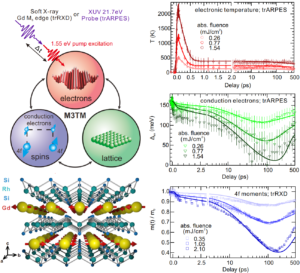
Understanding the microscopic mechanisms behind ultrafast magnetization dynamics remains an important issue in solid state physics. Numerous studies have successfully applied variations of three-temperature models to describe experimental ultrafast magnetization dynamics. By introducing effective temperatures for the transient electronic, lattice and spin degrees of freedom (see figure), the 3TM provides an intuitive, phenomenological approach for the quantitative analysis of ultrafast magnetization dynamics using three coupled differential equations to describe the mutual energy transfer between the subsystems. However, comparison of model predictions are often only made with one of the subsystems.
In our study (Adv. Mater. Interfaces 2201340 (2022)), we investigate the femtosecond dynamics of electronic temperature, sub-surface ferromagnetic ordering and bulk 4f antiferromagnetic ordering of antiferromagnetic GdRh2Si2 upon optical excitation at various pump fluences. For consistent description of the demagnetization dynamics, the microscopic 3TM model was applied. While the model qualitatively describes the experimental results well, quantitatively, it suggests a systematic effective increase of the phase transition temperature.